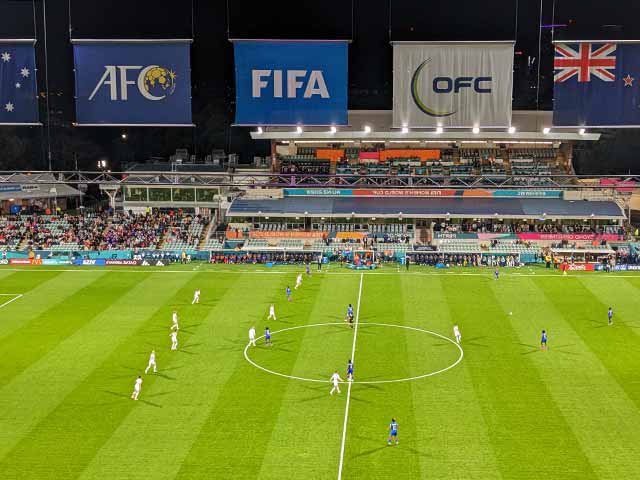The FIFA Women's World Cup is an international football (soccer) tournament for women's national teams. It was established by the Fédération Internationale de Football Association (FIFA), the governing body for world football, to provide women with the opportunity to compete at the highest level on the international stage.
 match between Denmark and Haiti at HBF Park in Perth, 2023
match between Denmark and Haiti at HBF Park in Perth, 2023 Precursor Tournaments
Before the establishment of the official Women's World Cup, there were sporadic international women's football tournaments and competitions, but none were recognized by FIFA as the official World Cup.
1970 Martini & Rossi Cup, Italy
In 1970, there was a football tournament named the women's football World Cup (also called the Martini & Rossi Cup) organized by the Federation of Independent European Female Football (FIEFF) in Italy in July 1970. The event featured women's teams from seven countries (Denmark, Italy, England, West Germany, Mexico, Austria and Switzerland). Denmark won the tournament after beating Italy 2–0 in the final.
1971 Women's World Cup, Mexico
One year later, the FIEFF organized another Women's World Cup tournament, held in Mexico City and Guadalajara in August and September 1971. Denmark again won, defeating Mexico 3–0 in the final.
Mundialito tournaments from 1981–1988
In the 1980s there were five tournaments called Mundialito (which in Spanish means little world cup). The first event was held in Japan in 1981. Another four were held in the north of Italy, in 1984, 1985, 1986, and 1988. Italy was the victor three times, England twice.
1988 FIFA Women's Invitation Tournament
The success and growing popularity of women's football in various countries prompted FIFA to organize a global competition for women. To test the feasibility of a Women's World Cup, FIFA organized the 1988 FIFA Women's Invitation Tournament. It was held China from 1 to 12 June 1988, between 12 national teams. Norway defeated Sweden 1–0 in the final. The competition was deemed a success, and FIFA organized the first official FIFA Women's World Cup to be held in China in 1991.
The Official World Cup
The inaugural FIFA Women's World Cup took place in 1991, with China as the host country. Twelve teams participated in the tournament, and the matches were played in Guangdong, Jiangsu, and Beijing. The United States emerged as the champions, defeating Norway 2-1 in the final held on November 30, 1991, at Tianhe Stadium in Guangzhou, China.
Since the first event in 1991, the Women's World Cup has been held every four years, with the number of participating teams gradually increasing. The tournament has seen tremendous growth in popularity and competitiveness, with more countries investing in women's football and developing strong national teams.
The first two events were 12-nation tournaments, becoming a 16-nation competition in 1999, and expanding to 24 teams for the 2015 event in Canada, the 32 teams for the 2023 World Cup in New Zealand and Australia.
Related Pages
- History of the men's FIFA World Cup
- Host cities for each women's event.
- Results of each Women's World Cup
- Women's World Cup Trivia, plus Firsts
- Men's FIFA World Cup


 Current Events
Current Events